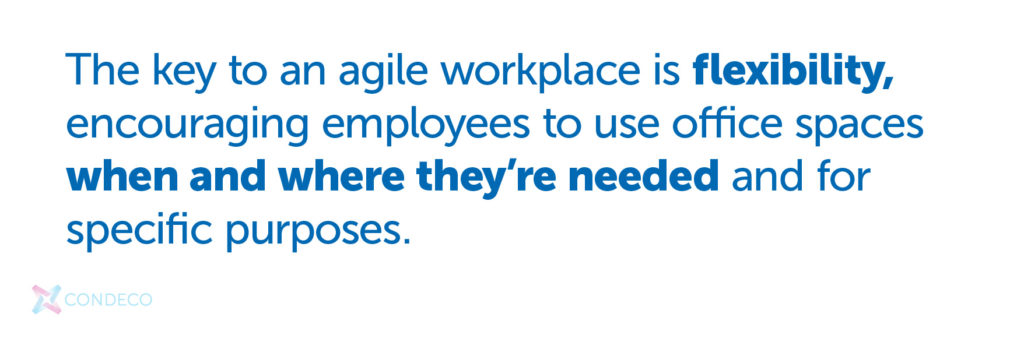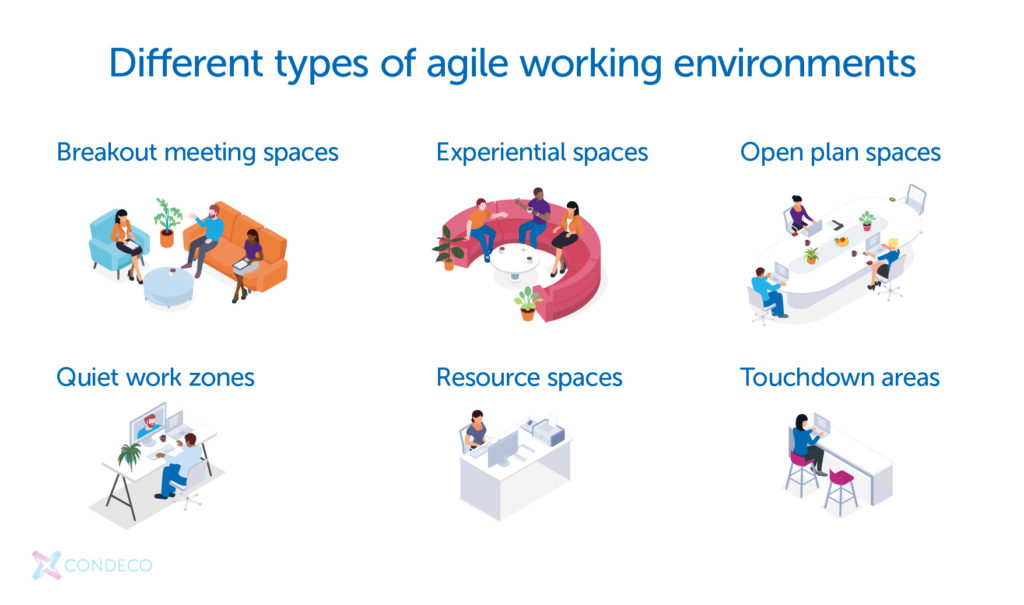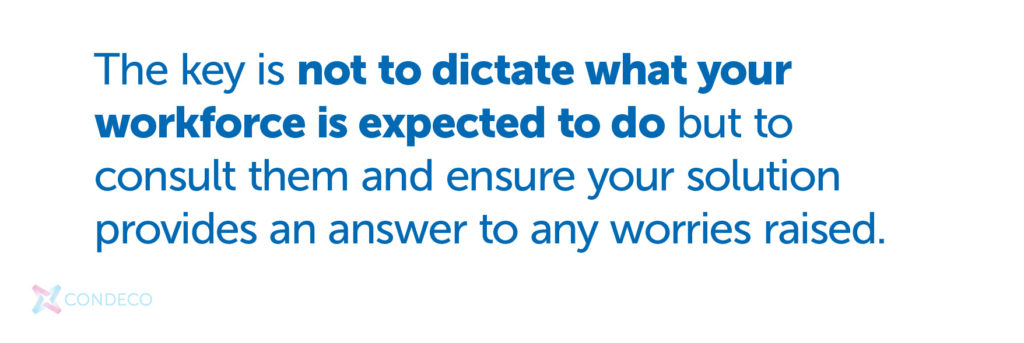
In a world that changes rapidly, businesses need to respond with agility. The pandemic and events in Eastern Europe are just the most serious examples of how unexpected challenges and opportunities can arise seemingly overnight. Often these are driven by rising customer expectations, new digital technology and the ever present danger of a disruptor brand entering the marketplace.
Standing still is therefore not an option and the rise of the agile working environment is widely regarded as one of the best ways to prepare for inevitable change and build a business that can respond quickly and effectively. It can offer certainty about schedules and free up capacity to build an office that truly is people-first and productivity focused.
But what is an agile working environment and how do you plan for one that is right for your business?
What is an agile workplace?
An agile workplace is one that is set up for the different ways people work now and the rise of hybrid working. Rather than being wedded to one desk, employees are free to work from home or outside the traditional 9-5 hours. The workplace facilitates this approach and makes time spent in the office more productive and enjoyable for employees.
Providing control

The key to an agile workplace is flexibility, encouraging employees to use office spaces when and where they’re needed and for specific purposes. The agile workplace offers certainty and control over what could be a chaotic process and creates the capacity to deal with immediate needs as well as longer term demands.
The use of technology to book desks and meeting spaces and intelligent interior design are vital so that employees can collaborate or be more productive when they do visit the office. The set-up also takes into account slow periods and predictable busy periods when office attendance is likely to be larger.
Why are agile workspaces so popular?
People have never been more receptive to flexible work and agile workspaces allow them to get the best out of both home and office working – the right space at the right time. Indeed, an agile workplace may be the magnet for attracting reluctant employees into the office where a day of creativity and collaboration provides a welcome change from intent focus at home.
For employers it can be a useful tool for employee retention and wellbeing. It also fosters creativity, collaboration and greater productivity if done properly. The financial benefits lie in making the most of the available space in an office, with the potential for downsizing and saving money in rent and power foe example. For the planet as a whole, it can reduce the environmental impact of a business with fewer people consuming resources on site and those resources being used more efficiently.
Different types of agile working environments

Not every agile working environment looks or feels the same and there are a number of options available to create a space that works for a specific business. These options include:
- Breakout meeting spaces – a basic building block of the agile workplace. It is often a quiet corner or room where impromptu meetings can be held that only last for a relatively short period of time.
- Experiential spaces – this is a breakout space with a purpose where people get together for a reason other than just talking business. For example it could serve coffee, show the news on television or even have a pool table.
- Open plan spaces – these are neutral areas to be used as part of a hot desking policy where cubicles are removed to foster new connections, cross departmental collaboration and a wider sharing of ideas.
- Quiet work zones – people still need to concentrate in the office and these are the spaces where they can get away from the noise and hubbub of the office to focus on a task in hand (‘deep work’ is currently the popular term for this).
- Resource spaces – this is the classic photocopier or printer area where the tools required for everyday office working are based. Some may use this space for quick catch ups but a constantly whirring machine can be a distraction for many so they should be placed away from the main working area.
- Touchdown areas – also known as ‘overflow areas’, these spaces are usually furnished with computers, screens and other facilities for use on a temporary basis. They provide a useful resource for the days when the main area is full or visiting customers need a place to work. Touchdown areas are not always essential and unlikely to be used all the time, but they can prove vital at certain moments in the working week.
Getting the right combination of all these areas is key to making agile working a reality for any business.
The challenges of an agile workplace
Transforming your business from a traditional office environment to an agile workplace can be a challenge and may take a little time. If your workforce is not onboard with the idea at the start then grumbles can quickly turn into resignations as people feel uncomfortable with the seeming lack of control they have over their working day.

It may be that gradual implementation is the best idea, starting with a hot desking area and breakout spaces rather than redesigning the office all in one go. The key is not to dictate what your workforce is expected to do but to consult them and ensure your solution provides an answer to any worries raised. After that, consider your business and its goals to create your agile work policy.
You should also investigate the technology required to support an agile workplace such as workspace booking software to ensure hot desking doesn’t turn into a free for all. This will also make any visit to your office manageable and a pleasure.
Is an agile workplace right for your business?
While agile is a proven way for many companies to empower productivity and increase employee happiness it may not be right for all businesses. It is most suited to enterprises where a lot of the work can be done online and face to face meetings are not always essential and where the focus is on output rather than attendance.
However, if you are looking to break free from the constraints of a 9 to 5 business and foster creativity, collaboration and motivation amongst your workforce, then the agile workplace should be a serious consideration.
What will you do with your office space?



